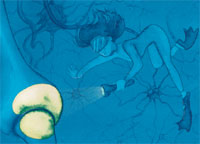
Long-term opiate use changes the way nerve cells work in the brain. This happens even to people who take opiates for a long time to treat pain, as prescribed by their doctor. The nerve cells grow so used to having opiates around that when they are taken away suddenly, the person can experience a wide range of symptoms in the brain and body. These are known as withdrawal symptoms.
Have you ever had the flu? You probably experienced symptoms such as aching, fever, sweating, shaking, or chills. These are similar to withdrawal symptoms, but withdrawal symptoms are much worse. Yuck!
That is why, when used as medicine, opiates should be carefully monitored by a doctor—so that a person knows how much to take and when and how to stop taking them to lessen the chances of withdrawal symptoms. Eventually, the cells will work normally again, but that takes time.
Someone who is addicted to opiates has other symptoms as well—they cannot control how much drug they take, even though it may be having harmful effects on their life and their health. They have strong urges to take the drug—called cravings—and they don’t feel satisfied by natural rewards (chocolate, a walk on the beach).




